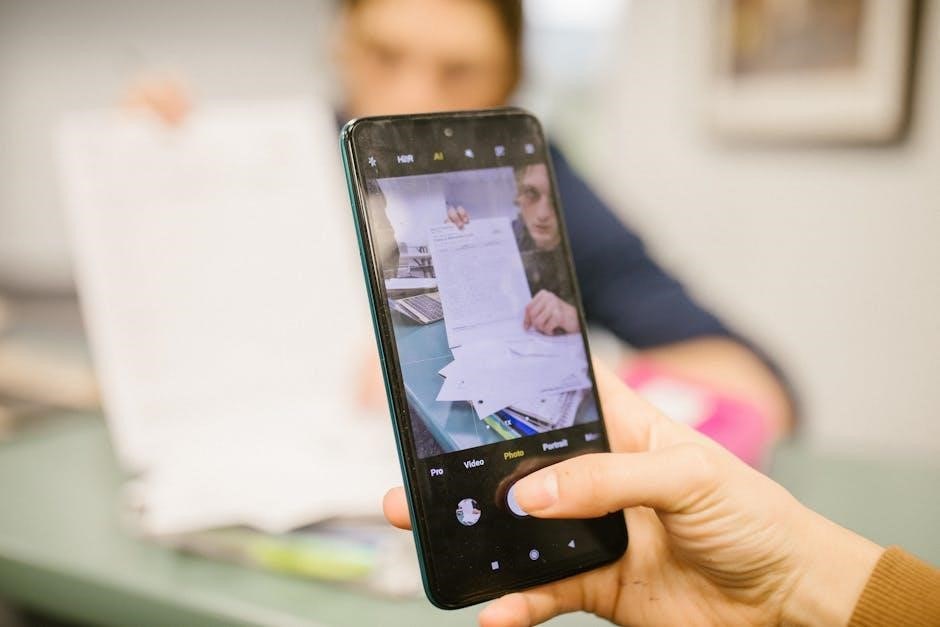classroom hand signals pdf free
Classroom hand signals are a powerful tool for non-verbal communication, helping teachers manage behavior and minimize disruptions. Popular and easy to implement, they enhance student engagement and inclusivity. With free PDF resources available, educators can access customizable posters and templates to create effective hand signal systems tailored to their classroom needs.
What Are Classroom Hand Signals?
Classroom hand signals are non-verbal cues used by teachers and students to communicate without disrupting lessons. These gestures, often taught through free PDF resources, include signs for common needs like asking for a pencil or permission. They are simple, consistent, and visually clear, making them an effective tool for maintaining focus and order in the classroom environment;
Importance of Non-Verbal Communication in the Classroom
Non-verbal communication, such as hand signals, plays a vital role in classroom management by reducing disruptions and fostering a focused learning environment. It encourages inclusivity, supporting students with varying needs, and enhances overall engagement. Free PDF resources provide teachers with tools to implement these strategies effectively, ensuring clear and consistent communication for all students. This approach promotes a respectful and efficient classroom atmosphere.
Benefits of Using Hand Signals in the Classroom
Hand signals enhance classroom management by minimizing disruptions and encouraging non-verbal communication. They promote inclusivity, support diverse learners, and foster a focused, respectful learning environment. Free PDF resources offer customizable posters to implement these strategies effectively.
Minimizing Classroom Disruptions
Hand signals effectively reduce classroom disruptions by providing non-verbal cues for common requests, such as restroom breaks or questions. This minimizes interruptions, allowing lessons to flow smoothly. Teachers can quickly address student needs without pausing instruction, creating a more focused and efficient learning environment; Free PDF resources offer customizable posters to implement these signals seamlessly.
Encouraging Student Participation and Engagement
Hand signals empower students to communicate comfortably, fostering participation without interrupting lessons. They provide non-verbal cues for questions, ideas, or needs, making students feel heard and confident. Multicultural signals further enhance inclusivity, ensuring all learners feel valued. Free PDF resources offer vibrant posters, enabling teachers to create an engaging and responsive classroom environment that encourages active student involvement and collaboration.
Supporting Inclusive Classroom Environments
Hand signals promote inclusivity by allowing diverse learners to express needs silently; Multicultural signals integrate sign language, ensuring accessibility for all students, including those with hearing impairments. Free PDF posters provide visual reminders, fostering a welcoming environment where every child can communicate confidently, regardless of their background or abilities, enhancing overall classroom unity and understanding.

How to Create Effective Classroom Hand Signals
Design clear, consistent gestures that students can easily understand. Use free PDF templates to customize signals, ensuring they align with classroom needs and promote seamless communication.
Designing Clear and Consistent Hand Gestures
Creating clear and consistent hand gestures is essential for effective classroom communication. Use simple, distinct movements that students can easily mimic. Avoid complex gestures that may confuse. Ensure each signal has a specific purpose, like raising a hand for questions or making a “zip it” gesture for silence. Consistency helps students quickly understand and adopt the signals, enhancing classroom management and reducing disruptions. Free PDF resources offer templates and examples to guide the design process, ensuring clarity and uniformity in non-verbal communication.
Teaching Hand Signals to Students
Introducing hand signals to students requires clear instruction and consistent practice. Begin by demonstrating each gesture and explaining its purpose. Use visual aids like posters or flashcards to reinforce learning. Encourage students to practice the signals during class activities, ensuring they understand when and how to use them. Free PDF resources provide editable templates and tutorials, making it easy to teach and reinforce hand signals effectively in the classroom setting. This method ensures all students grasp the system quickly and confidently.
Customizing Signals for Specific Classroom Needs
Teachers can tailor hand signals to suit their classroom requirements, addressing unique challenges like special needs or language barriers. Free PDF templates offer editable designs, allowing customization for actions like “restroom” or “question.” Multicultural signals, such as those using ASL, promote inclusivity. Adapting signals ensures they align with classroom rules and student needs, enhancing their effectiveness in maintaining order and encouraging participation.

Multicultural Hand Signals for the Classroom
Multicultural hand signals promote inclusive communication, blending diverse gestures and sign languages. Free PDF resources offer vibrant posters, ensuring all students, regardless of background, can participate and understand cues effectively.
Using Sign Language in Classroom Communication
Sign language enhances classroom communication by providing non-verbal cues for common phrases like greetings, requests, and affirmations. Teachers can use free PDF resources, such as ASL flashcards, to teach students essential signs, fostering inclusivity and engagement. This approach supports diverse learners, including those with hearing impairments, and promotes a culture of respect and understanding in the classroom environment.
Cultural Considerations for Hand Signal Design
When designing hand signals, consider cultural diversity to ensure inclusivity. Use universal gestures that resonate across different backgrounds. Avoid signals with unintended meanings in other cultures; Incorporate multicultural elements, such as sign language, to promote respect and understanding. Free PDF resources often include culturally sensitive designs, helping teachers create signals that align with diverse student needs and foster an inclusive learning environment.
Examples of Multicultural Hand Signals
Examples include hand signals for common needs like restroom, drink, or pencil, ensuring non-verbal communication. Multicultural signals incorporate diverse gestures, such as sign language for “hello” or “thank you.” These inclusive designs minimize disruptions and promote equity. Free PDF resources offer visually consistent templates teachers can customize for their classrooms, ensuring clarity and accessibility for all students.
Free PDF Resources for Classroom Hand Signals
Free PDF resources offer customizable hand signal templates, multicultural designs, and editable posters to enhance classroom management. These tools are easily downloadable and adaptable for diverse teaching needs.
Popular Free PDF Downloads for Teachers
Teachers can access free PDFs featuring vibrant hand signal posters, multicultural designs, and customizable templates. These resources include signals for common needs like restroom breaks, questions, and tissues, ensuring efficient communication. Available in various sizes, they cater to different classroom settings, making it easy for educators to minimize disruptions and maintain focus seamlessly.
How to Find and Download Classroom Hand Signal PDFs
Teachers can easily find free classroom hand signal PDFs by searching educational platforms like Teachers Pay Teachers or Pinterest. Use keywords like “free classroom hand signals PDF” or “multicultural hand signal posters” to locate resources. Many websites offer downloadable files, including editable templates and vibrant designs, making it simple to access and print materials for immediate classroom use.
Editable and Customizable Hand Signal Templates
Editable hand signal templates offer flexibility for teachers to tailor signals to their classroom needs. Available in formats like Google Slides or Microsoft Word, these templates allow customization of designs, colors, and text. Teachers can adapt signals for different age groups or special needs, ensuring inclusivity and engagement. Customizable templates also enable educators to align hand signals with their teaching style and classroom environment seamlessly.

Implementing Hand Signals in the Classroom
Introduce hand signals early in the school year to establish clear communication. Consistently use and reinforce signals daily, ensuring students understand their meaning and importance for a smooth classroom environment.
Introducing Hand Signals to Students
Introduce hand signals at the beginning of the school year to establish clear communication; Use free PDF posters to visually demonstrate each signal’s meaning. Practice the gestures together as a class, ensuring students understand when and how to use them. Make it engaging by incorporating fun or unique signals that students can easily remember and replicate. Consistency is key to successful implementation.
Ensuring Consistency in Signal Use
Consistency is vital for effective hand signal use. Display free PDF posters prominently in the classroom to serve as visual reminders. Regularly review signals during lessons and encourage students to use them correctly. Teachers should model the gestures frequently to reinforce their meaning and ensure uniformity across the class, making communication seamless and efficient for everyone involved.
Encouraging Student Mastery of Hand Signals
Students master hand signals through practice and positive reinforcement. Teachers can distribute free PDF guides and posters, offering visual cues that support learning. Incorporating signals into daily routines helps students internalize their meanings. Recognizing correct usage and providing gentle corrections fosters confidence and fluency, ensuring the system becomes an effective communication tool for all learners.
Classroom Hand Signal Posters and Visual Aids
Free PDF posters offer vibrant, customizable designs for classroom hand signals, ensuring clear communication. These visual aids help students quickly understand and use non-verbal cues effectively, minimizing disruptions and fostering an inclusive learning environment.
Creating Eye-Catching Posters for the Classroom
Designing visually appealing posters involves using bright colors, clear graphics, and simple text. Free PDF templates offer customizable options to match classroom themes. Teachers can add relevant hand signals, ensuring each poster is easy to understand. High-quality images and consistent layouts help capture students’ attention, making the posters both functional and decorative for the learning environment.
Using Visual Reminders to Reinforce Hand Signals
Visual reminders, such as posters and flashcards, help reinforce hand signals by providing constant cues. Placing them strategically around the classroom ensures students can easily reference the gestures. Free PDF resources offer ready-to-print materials, making it simple for teachers to maintain consistency and remind students of the expected signals without verbal prompts, enhancing overall classroom management and efficiency.
Displaying Posters in Strategic Locations
Placing hand signal posters in high-traffic areas, such as near classroom entrances or supply stations, ensures visibility. Positioning them at students’ eye level maximizes their effectiveness. Free PDF templates offer vibrant designs that can be printed and displayed to consistently reinforce non-verbal cues, fostering a well-managed and inclusive classroom environment.
Technology Integration with Hand Signals
Digital tools enhance hand signal learning through interactive tutorials and editable templates. Free PDFs and Google Classroom resources allow teachers to distribute and teach signals efficiently online.
Digital Tools for Teaching Hand Signals
Digital tools like Google Classroom and interactive tutorials make teaching hand signals efficient. Free PDFs and editable templates allow customization, while online platforms enable easy distribution and access for students. These resources enhance engagement and streamline the learning process, ensuring consistency and mastery of hand signals in the classroom environment.
Using Google Classroom for Signal Distribution
Google Classroom offers a seamless way to distribute hand signal resources. Teachers can upload free PDFs and editable templates, assigning them to students for easy access. This platform ensures materials are readily available, promoting consistent use of hand signals and fostering a structured communication system within the classroom environment.
Interactive Hand Signal Tutorials for Students
Interactive hand signal tutorials engage students through animations, videos, and quizzes. Teachers can create digital modules using free PDF templates, adding clickable elements for practice. These tutorials cater to diverse learning styles and include multicultural signals, fostering inclusivity. They simplify mastering hand signals, making classroom communication efficient and fun for all students.
Case Studies and Success Stories
Real-world classroom applications highlight the effectiveness of hand signals. Teachers report reduced disruptions, improved focus, and enhanced student engagement. Success stories reveal how these tools foster a positive, organized learning environment.
Teachers’ Experiences with Hand Signals
Teachers have shared positive experiences with classroom hand signals, emphasizing their effectiveness in minimizing disruptions and improving student focus. Many educators appreciate the minimal preparation required and the ease of integrating these signals into daily routines. By using free PDF resources, teachers can quickly access customizable posters and templates, making implementation straightforward and efficient for all classroom settings.
Positive Impact on Classroom Management
Hand signals have shown a significant positive impact on classroom management by reducing disruptions and improving student focus. They create a structured environment where non-verbal cues help students self-regulate their behavior. Free PDF resources provide teachers with customizable posters and templates, enabling them to implement these signals effectively and maintain a productive, inclusive classroom setting.
Student Feedback on Hand Signal Usage
Students often express enthusiasm for hand signals, finding them fun and engaging. They appreciate the clarity and efficiency of non-verbal communication, which helps them stay focused and avoid disruptions. Many students enjoy learning and using these signals, creating a sense of ownership and responsibility in maintaining a positive classroom environment. Free PDF resources make it easy for teachers to implement these tools effectively.
Expanding Hand Signal Systems
Hand signal systems can be expanded to meet advanced needs, incorporating multicultural gestures and combining signals with other classroom management tools for enhanced effectiveness and inclusivity.
Advanced Hand Signals for Complex Needs
Advanced hand signals can address specific challenges in diverse classrooms, offering tailored solutions for students with unique requirements. These signals are designed to be clear, consistent, and adaptable, ensuring effective communication while fostering an inclusive environment. Free PDF resources provide customizable templates, enabling teachers to create signals that cater to complex needs and enhance classroom management.
Combining Hand Signals with Other Management Tools
Integrating hand signals with other classroom management tools enhances their effectiveness, reinforcing student engagement and discipline. Free PDF resources offer templates that allow teachers to merge hand signals with visual reminders and behavioral charts, creating a comprehensive system that minimizes disruptions and maximizes learning opportunities for all students in a structured environment.
Adapting Signals for Different Age Groups
Hand signals can be tailored for various age groups, ensuring effectiveness across different developmental stages. For younger students, simple and visually clear gestures are recommended, while older students can learn more complex signals. Free PDF resources provide adaptable templates, allowing teachers to customize signals to meet the unique needs of their students, fostering inclusivity and engagement across all age levels.

Best Practices for Teachers
Introduce hand signals gradually, ensuring consistency and clarity. Encourage parental involvement by sharing free PDF resources, fostering a collaborative learning environment and promoting student understanding and participation effectively.
Establishing Clear Expectations
Begin by introducing hand signals early in the school year, ensuring students understand their purpose. Use free PDF posters as visual reminders to reinforce expectations consistently. Teachers should demonstrate each signal clearly and explain when to use them. Consistency is key to helping students adapt quickly. Involve parents by sharing free PDF resources, fostering a collaborative environment and ensuring students understand the signals both in and out of the classroom. This approach minimizes disruptions and promotes a more inclusive, organized learning space.
Regularly Reviewing and Updating Signals
Periodically review hand signals to ensure they remain effective and relevant. Use free PDF resources to update or add new signals as needed. Involve students in the process, allowing them to suggest improvements. Consistent review ensures clarity and adaptability, keeping classroom communication smooth and aligned with evolving needs. This proactive approach enhances overall classroom management and engagement, fostering a more responsive learning environment.
Encouraging Parental Involvement
Share free PDF hand signal resources with parents to promote consistency at home. Encourage them to review and discuss the signals with their children, fostering a collaborative learning environment. Involving parents strengthens communication and reinforces classroom management strategies, ensuring students receive consistent cues both at school and home, enhancing overall behavioral and academic success.
Classroom hand signals are a simple yet effective tool for enhancing communication and management. With free PDF resources available, teachers can easily implement these strategies, fostering engagement and inclusivity while maintaining order. By promoting consistency and clarity, hand signals create a positive learning environment for all students.
Summarizing the Value of Hand Signals
Classroom hand signals offer a simple, non-verbal way to manage student behavior and maintain focus. They minimize disruptions, promote inclusivity, and encourage participation. By using free PDF resources, teachers can access customizable posters and templates to create effective systems. These tools enhance communication, support diverse needs, and foster a positive, organized learning environment for all students.
Encouraging Continuous Improvement in Classroom Communication
Hand signals foster a structured, respectful environment, enhancing communication and reducing misunderstandings. They adapt to diverse needs, ensuring every student can participate. Regularly updating signals keeps them relevant, while free PDF resources provide inspiration. By refining hand signal systems, teachers create a dynamic, inclusive space that evolves with their students, promoting continuous growth in classroom interactions and engagement.